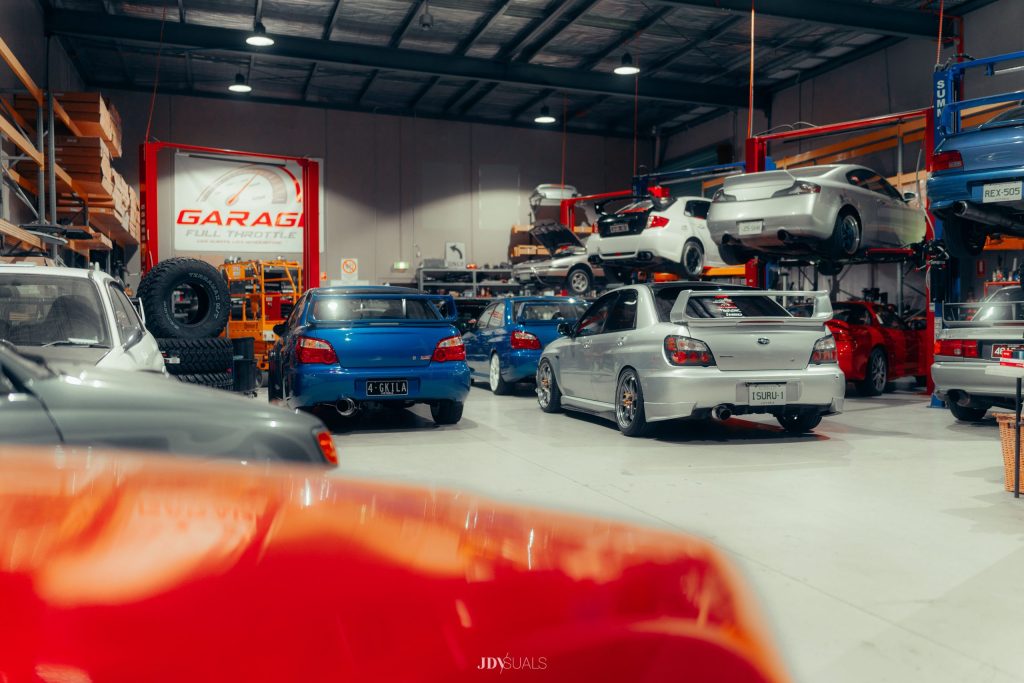As a trusted Subaru Specialist serving Craigieburn, Wollert, and the surrounding Melbourne areas, we’ve seen our fair share of Subaru head gasket failures in these beloved vehicles. Whether you’re a new Subaru owner or an experienced mechanic looking to expand your knowledge, understanding the intricacies of Subaru head gaskets can save you thousands in repairs and prevent significant engine damage.
Why Subaru Head Gaskets Are Different
Subaru’s horizontally opposed (boxer) engine design is part of what makes these vehicles unique. It delivers a lower centre of gravity and improved handling. However, this unique design also creates specific challenges when it comes to head gasket reliability, particularly in models produced between 1996 and 2009.
As any experienced Subaru Mechanic knows, these vehicles typically use composite (multi-layer steel) head gaskets that seal the junction between the engine block and cylinder heads. In the boxer engine configuration, these gaskets are positioned differently than in conventional engines, with some areas exposed to different temperature and pressure dynamics.
Common Signs of Head Gasket Failure in Subarus
Before we dive into prevention and solutions, let’s identify the warning signs that might indicate your Subaru’s head gasket is beginning to fail:
- External oil leaks – Look for oil seepage between the engine block and cylinder heads
- External coolant leaks – Coolant may leak from the same area, often visible after the car has been parked overnight
- White smoke from exhaust – Indicates coolant entering the combustion chamber
- Bubbling in the radiator or overflow tank – Suggests combustion gases entering the cooling system
- The sweet smell from the engine bay – The distinct aroma of burning coolant
- Engine overheating – Particularly during highway driving or climbing hills
- Loss of coolant with no visible leaks – Coolant may be burning internally
- Oil that resembles a milkshake – Indicates coolant mixing with oil
- Cylinder misfire – When coolant enters combustion chambers
If you notice any of these symptoms, it’s crucial to consult with a Subaru Specialist immediately. Continued driving with a failing head gasket can lead to catastrophic engine damage.
The Science Behind Subaru Head Gasket Failures
For the technically inclined and professional mechanics, understanding the metallurgy and thermal dynamics at play helps explain why these failures occur:
Subaru’s EJ series engines (particularly the EJ25) used composite head gaskets with a steel core and soft-facing material. Over time, several factors contribute to their deterioration:
- Electrolysis—The combination of aluminium heads, iron blocks (in some models), and coolant chemistry can create a mild electrical current that accelerates the corrosion of the gasket material.
- Thermal cycling—The boxer engine design creates uneven heating and cooling patterns across the gasket surface, causing expansion, contraction, and, eventually, fatigue.
- Coolant chemistry—Subaru’s original coolant specifications may not adequately protect its head gaskets against the specific conditions they encounter.
- Clamping force variations—The boxer engine’s long, narrow design can create uneven clamping forces across the gasket surface.
Prevention Strategies for All Subaru Owners
Whether you’re a new owner wanting to avoid problems or an enthusiast planning Subaru performance upgrades, these preventative measures can significantly extend head gasket life:
1. Coolant Maintenance
- Use Subaru Super Coolant or an equivalent high-quality coolant formulated explicitly for aluminium engines.
- Maintain proper coolant concentration (usually 50/50 mix with distilled water)
- Change coolant according to maintenance schedule (typically every 30,000 miles)
- Consider adding a coolant conditioner that helps prevent electrolysis.
2. Regular Monitoring
- Check coolant levels weekly (engine cold)
- Inspect for any signs of leaks around the engine.
- Monitor engine temperature during normal driving.
- Perform regular compression and leak-down tests if you have the equipment.
3. Driving Habits
- Allow proper warm-up before aggressive driving.
- Avoid prolonged idling, which can create hot spots.
- Ensure the cooling system is functioning optimally before any high-performance driving.
4. Proactive Replacement
- Consider preemptively replacing head gaskets with upgraded versions for high-mileage Subarus (especially EJ25 engines from 1996-2009).
- Always use OEM or high-quality aftermarket gaskets explicitly designed for Subarus when replacing.
Technical Solutions for the DIY Mechanic
For those comfortable with advanced mechanical work, here’s a technical breakdown of a proper head gasket replacement on a Subaru:
Required Tools and Parts:
- A complete head gasket set is specific to your Subaru model.
- Torque wrench capable of accurate readings in the 70-75 ft-lb range
- Angle gauge for torque-to-yield bolts
- Surface preparation tools (Scotch-Brite pads, solvent)
- The straightedge and feeler gauge will be used to check for warpage.
- Thread chaser set
- Engine stand or adequate support system
- Factory service manual
Critical Procedure Highlights:
- Proper Surface Preparation: The aluminium cylinder heads must be perfectly clean and flat.
- Check cylinder heads for warpage (maximum allowable is typically 0.002″)
- Use appropriate cleaning methods that don’t scratch the sealing surface.
- Bolt Replacement and Torquing: Always replace head bolts if they are torque-to-yield type.
- Follow the exact torque sequence and specifications from the factory manual.
- A multi-stage torquing process is used to clamp even force.
- Timing Belt Service: Since the timing belt must be removed, always replace it during head gasket service.
- Replace the water pump, tensioners, and pulleys while access is easy.
- Cooling System Renewal: Completely flush the cooling system before reassembly.
- Replace thermostat, radiator cap, and hoses if they show any wear.
Performance Considerations for Enthusiasts
For those interested in Subaru Tuning and performance upgrades, head gasket concerns become even more important:
Impact of Performance Modifications:
When installing aftermarket Subaru parts or upgrading your Subaru exhaust system, consider how these modifications affect head gasket reliability:
- Increased Boost Pressure: Higher boost creates additional stress on head gaskets.
- It may require upgraded multi-layer steel (MLS) head gaskets.
- Engine Tuning: Professional Subaru Tuning should account for head gasket limitations.
- Consider cylinder head studs instead of bolts for increased clamping force.
- Aftermarket Parts: Quality Subaru parts from reputable manufacturers are crucial.
- Beware of performance parts that increase thermal stress on the engine.
Recommended Upgrades for Performance Applications:
- Multi-Layer Steel Head Gaskets: Brands like Cometic and Six Star offer performance-oriented gaskets
- ARP Head provide more consistent and higher clamping force than factory bolts
- Upgraded Cooling System: Higher capacity radiator
- Performance water pump
- Oil cooler to reduce overall engine temperature
When to Seek Professional Help
While DIY maintenance is commendable, some situations call for professional assistance:
- If you’ve never performed major engine work before
- When specialized tools like a torque angle gauge aren’t available
- If your Subaru is still under warranty
- When the diagnosis is uncertain (not all coolant leaks are head gasket related)
- For performance-built engines where precision is critical
A qualified Subaru Specialist has the experience and specialized equipment to diagnose and repair head gasket issues properly.
Costs and Considerations
Head gasket replacement is one of the more expensive maintenance items for a Subaru. Understanding the costs can help you make informed decisions:
- DIY Costs: $300-600 for quality parts and consumables
- Professional repair: $2,500-3,500 depending on location and exact model
- Upgraded Performance Parts: Add $300-600 to either estimate
- Additional Repairs: Often discovered during disassembly, potentially adding $500+
The Future of Subaru Head Gaskets
The good news for newer Subaru owners is that the company has significantly improved head gasket design in models produced after 2012. The FA and FB series engines use improved materials and designs that have largely resolved the chronic issues of earlier generations.
Conclusion
Understanding your Subaru’s head gasket health is essential for the long-term enjoyment of these unique vehicles. Whether you’re a new owner performing essential maintenance or an experienced mechanic planning extensive Subaru performance upgrades, proactive attention to head gasket health will save time, money, and frustration.
The boxer engine’s unique character makes a Subaru special. With proper care, your Subaru can deliver hundreds of thousands of trouble-free kilometres.
Get Expert Subaru Head Gasket Service Today
Don’t wait until you’re stranded on the side of the road with an overheating engine! At Garage Full Throttle, our team of certified Subaru Specialists is ready to help with:
- Complete Head Gasket Inspections and Diagnostics
- Preventative Head Gasket Replacement
- Performance Head Gasket Upgrades
- Custom Subaru Tuning Services
Contact us today to schedule an inspection or repair of your Subaru head gasket. Our team serves Craigieburn, Wollert, Somerton, Roxburgh Park, and all surrounding Melbourne areas with specialized knowledge in Subaru maintenance, performance upgrades, and custom tuning solutions.
Visit our Logbook Service page to maintain your Subaru’s warranty while ensuring your head gasket remains in peak condition.

